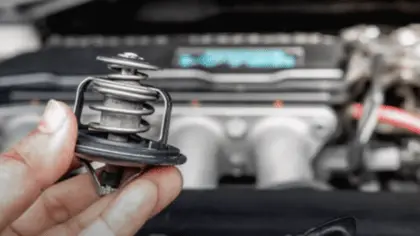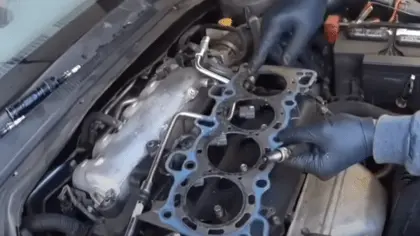A thermostat is a tiny yet crucial part of the car’s cooling system that can cause major damage to the engine if it fails. But can a bad thermostat cause a blown head gasket? Yes. A bad thermostat can overheat the engine and blow the head gasket eventually. However, you can fix this issue cheaply by reacting quickly.
Read on to learn how a faulty thermostat can cause a blown gasket, the symptoms of the blown gasket, and how to fix it permanently at a low cost.
Can a Bad Thermostat Cause a Blown Head Gasket?

In short, a faulty thermostat can cause the cooling system to overheat and blow the car’s head gasket. Even driving an overheated engine for a few minutes is enough to blow the head gasket.
Compared to modern vehicles, older cars tend to cause this problem more. The reason is that after running an engine over 100,000 miles (260,000 km), it can’t tolerate running out of coolant and oil more efficiently than a new engine.
In addition, a bad thermostat is stuck in the closed position and can’t deliver coolant to the radiator, which overheats the engine and ends up causing the blowing of the head gasket. The driver’s neglect, like not watching the warning light or monitoring the gauge and keeping driving, is also responsible for the hassle.
Apart from affecting the heating and cooling system, a bad thermostat can hurt several parts of the engine. Hence it should keep optimum condition and be repaired by an expert mechanic if required.
How Does a Thermostat Blow a Head Gasket?
A thermostat usually keeps opening and closing to maintain the engine coolant temperature. and it has a certain temperature to regulate. For example, a car’s 195-degree F thermostat remains closed if the engine coolant temperature stays below it.
In this situation, the coolant won’t flow through the radiator. Instead, the coolant flows through the heater core to let the cabin warm the engine. It also flows around the engine block to warm it up. If the temperature rises above 195 degrees F, the thermostat opens.
As a result, the coolant system starts flowing through the radiator and gets back into the engine so the outside air can cool the engine down to less than 195 degrees F. This process repeats again and again.
But a bad thermostat remains closed for a long time, which prevents the coolant from flowing through the radiator and increases the engine temperature, resulting in overheating the engine and blowing it.
Apart from the bad thermostat, a blown head gasket can occur for plenty of reasons, including cylinder head warping, using low-quality parts, and getting older. There are also some signs that indicate a blown head gasket. Keep reading to learn more details.
Symptoms of a Blown Head Gasket

Below are some common signs of a blown head gasket that are worth knowing to fix earlier before getting worse:
Engine Overheating
Engine overheating is a sure sign of a leaking head gasket. It can also happen due to the injection of hot combustion gases and hot oil vapor into the coolant, which makes the coolant loss obvious. Traveling long distances can also overheat the engine.
Overheated engines lead to a slew of issues and increase the risk of metal parts expanding over the design limit, which causes cracks and warping. Even though it can damage the gasket and seals permanently, leaking the engine is the worst result.
Milky Build-Up
Checking under the oil filler cap is an easier way to determine if the head gasket is blown. If you notice the inside of the oil cap is dry, the head gasket is okay.
However, if you find a milky brownish-yellow substance, this indicates that the gasket has leaked. Contaminated engine oil can’t protect the engine. In this case, replacing the head gasket is a better idea.
Tailpipe Smoke
As you know, the head gasket regulates the flow of coolant through the engine. But a leaky head gasket can let the coolant seep into the combustion chamber, where it’ll burn with gasoline. As a result, you may notice gray or white smoke continuously coming from the tailpipe. It’s also a clear symptom of a faulty head gasket.
Rough Idle
The cylinder of an engine usually keeps a high-pressure level inside it. But if the head gasket gets damaged, the engine won’t be able to hold the right pressure level, resulting in an idle that’s rough and a poor run. Rough idle is an obvious sign of a bad head gasket, which you shouldn’t take lightly.
Will a Car Still Run With a Blown Head Gasket?
Though you can drive your car with a blown head gasket, you shouldn’t do so. Otherwise, this ignorance can cause serious damage to the engine and hurt your wallet as well. The reason is that the longer you keep driving with a blown head gasket, the more the engine will get damaged.
If you fail to repair it quickly, this will cost you thousands in repairs. Taking the risk of ruining the engine isn’t a wise decision either.
What if you discover a blown head gasket during the long tour? How long can you run your car with a blown head gasket? You can’t go very long. However, it’ll give you some time to take the car to the automotive repair shop to fix the problem before it gets worse. A blown head gasket prevents the car from getting enough power during driving, making it difficult to keep the car running.
Another question is whether it is safe to drive a car if its head gasket blows. No. Driving with a blown head gasket will not only damage the engine but also put you at risk. Hence, it is better to repair the blown head gasket.
How to Fix a Blown Head Gasket without Replacing It?

Though you can simply replace a blown head gasket, this will cause some complications. After replacing the head gasket, it can still overheat the engine, particularly if the repair isn’t performed properly and completely.
It can also cause engine blocks, warped cylinder heads, and failing timing belts. In addition, replacing the head gasket is a very tiresome and time-consuming job as it requires removing and replacing the engine head.
Hence, it’s better to repair the head gasket even if it costs $750 to $1500 on average. Once again, the longer you take to identify the problem, the harder it will be on your wallet with the high repair costs. Repairing a blown head gasket is a bit expensive because it requires plenty of labor to find the problem.
However, you can reduce the cost by diagnosing the problem and repairing your garage. The steps are:
- Replacing the coolant with water
- Starting the engine
- Pouring gasket repair liquid into the radiator
- Leaving the engine idle for around one hour
However, the process is quite trickier, and it’s better to take the car to an auto shop to repair the gasket and related issues.
Where to Take the Car to Repair Blown Head Gasket?
If you are wondering where to go, two reliable names are Capitol Toyota and K-Seal.
The Capitol Toyota has a team of factory-trained mechanics who can repair blown head gaskets professionally using original OEM parts.
Conversely, K-Seal is a manufacturer of the best head gasket sealer, and most of the leading recovery repair organizations use their technology to fix engine problems. They can permanently repair most head gasket issues, including:
- Blown head gasket
- Coolant to cylinder leaks and oil leaks
- Cylinder to coolant leaks.
FAQs
1. Can a bad thermostat cause bubble in the coolant reservoir?
A faulty thermostat doesn’t open and closes at the right time. Hence, it can produce a bubbling effect in the radiator or coolant reservoir due to uncontrolled airflow.
2. What is the main reason for causing the head gasket?
Engine overheating is the most common and primary cause of blown head gaskets. If the engine becomes too hot, the temperature of the gasket goes beyond what can be handled, which can cause failure in an extreme situation.
3. Will a bad head gasket cause no heat?
A bad gasket doesn’t let the cooling system hold water, and the cabin heater can’t function without water. As a result, you may feel no heat in the cabin.
Related Article: Coolant Reservoir Does Not Drain Back Into Radiator
Final Words
A bad thermostat can cause a blown head gasket, no heat, engine overheating, and more. However, it isn’t as serious as damaging your car, particularly if you respond quickly. And it’s true for all the other problems related to cars and everything in real life. I hope you found that information useful in your efforts to save your car engine and keep maintenance costs low.

